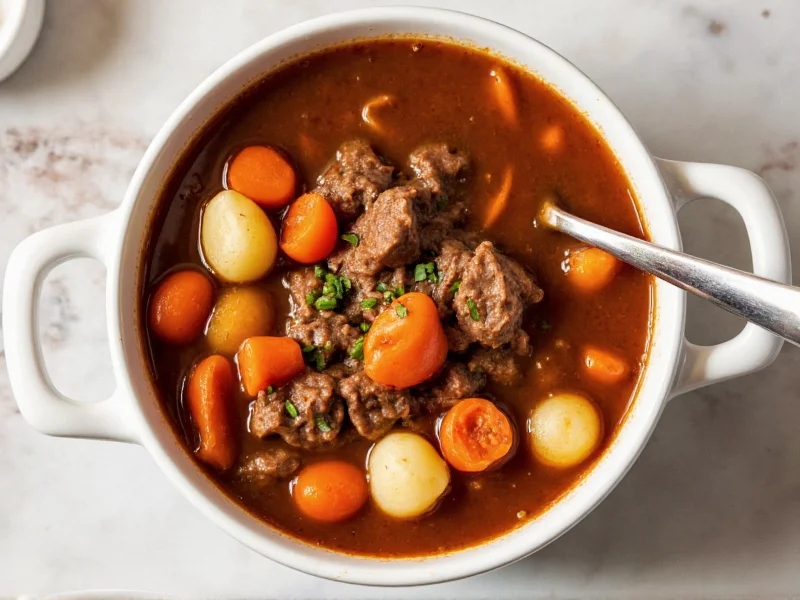Beef soup remains one of the most universally loved comfort foods across cultures. Whether you're seeking a quick weeknight meal or an impressive weekend project, understanding the fundamentals transforms ordinary broth into extraordinary culinary experiences. This guide delivers time-tested techniques and authentic variations that consistently produce flavorful, satisfying results.
Essential Components of Perfect Beef Soup
Creating exceptional beef soup requires attention to three critical elements: ingredient quality, cooking methodology, and flavor balance. High-quality bone-in cuts like chuck roast or oxtail release collagen during slow cooking, creating that signature silky texture impossible to replicate with store-bought broth alone. The maillard reaction—achieved by properly browning meat before simmering—develops complex flavor compounds that form the soup's foundation.
Classic Beef Soup Recipe Framework
Follow this professional chef-tested framework for consistently excellent results. This easy beef soup recipe for beginners yields six servings with approximately 45 minutes of active preparation and 2.5 hours of simmering time.
| Ingredient | Measurement | Preparation Notes |
|---|---|---|
| Beef chuck roast | 2 lbs, cubed | 1.5-inch cubes with some fat marbling |
| Yellow onions | 2 medium, diced | Yellow onions provide ideal sweetness |
| Carrots | 3 medium, sliced | Uniform 1/4-inch slices for even cooking |
| Celery ribs | 3 stalks, diced | Include leafy tops for extra flavor |
| Tomato paste | 2 tbsp | Concentrated flavor without acidity |
| Garlic cloves | 4, minced | Freshly minced for maximum aroma |
| Beef bones | 2 lbs | Knuckle or marrow bones preferred |
| Bay leaves | 2 | Remove before serving |
| Thyme sprigs | 4 | Bundle with kitchen twine for easy removal |
| Water | 8 cups | Cold, filtered water preferred |
Step-by-Step Preparation Guide
Dry and season meat: Pat beef cubes thoroughly dry with paper towels—moisture prevents proper browning. Season generously with kosher salt and freshly ground black pepper.
Sear in batches: Heat heavy-bottomed pot over medium-high heat with 2 tbsp oil. Sear meat in single layer without crowding (work in batches), turning until deeply browned on all sides. Transfer to plate.
Sauté aromatics: In same pot, add onions, carrots, and celery. Cook 8-10 minutes until softened and lightly caramelized. Stir in tomato paste and cook 2 minutes until brick red color develops.
Build foundation: Return meat to pot with any accumulated juices. Add garlic, bay leaves, thyme, and bones. Cover with cold water (8 cups). Bring to gentle simmer—never a rolling boil.
Simmer patiently: Partially cover and maintain gentle simmer for 2-2.5 hours. Skim foam periodically during first 30 minutes. Meat should pull apart easily with fork when done.
Final seasoning: Remove bones and herb bundle. Season with additional salt only after reducing—if needed. Acid balance with 1 tbsp apple cider vinegar enhances overall flavor.
Authentic Regional Variations
Master these traditional beef soup recipes from around the world to expand your culinary repertoire:
- French Boeuf Bourguignon: Substitute 2 cups red wine for equal water portion. Add pearl onions and mushrooms during last 45 minutes. Traditional with beef cheeks for superior texture.
- Korean Seolleongtang: Simmer beef bones 12-18 hours until broth turns milky white. Serve with rice, thin sliced beef, and scallions. Critical to maintain consistent low temperature.
- American Beef and Barley: Add 1 cup rinsed pearl barley with 1 hour remaining cooking time. Include diced potatoes and green beans during final 30 minutes for hearty texture.
- Hungarian Goulash: Double paprika (2 tbsp sweet, 1 tsp hot). Add diced potatoes and optional caraway seeds. Traditional with cubed beef simmered until fork-tender.
Dietary Adaptation Strategies
Create healthy beef vegetable soup options that maintain flavor while accommodating dietary needs:
Low-sodium version: Use homemade broth without added salt. Boost flavor with additional aromatic vegetables, 2 strips of kombu seaweed (remove before serving), and finish with fresh lemon juice. Sodium content reduces by 65% compared to standard recipes.
Gluten-free preparation: Naturally gluten-free when using cornstarch slurry (1 tbsp cornstarch + 2 tbsp cold water) instead of flour for thickening. Avoid pre-made broth which often contains gluten.
Instant Pot method: For quick beef soup recipes, pressure cook 35 minutes at high pressure followed by natural 15-minute release. Yields comparable depth of flavor in 1/3 the time of stovetop method.
Critical Mistakes to Avoid
Even experienced cooks make these common errors that compromise results:
- Rushing the sear: Crowding the pan lowers temperature, causing meat to steam instead of brown. Proper browning creates 70% of the soup's flavor foundation.
- Boiling instead of simmering: Vigorous boiling emulsifies fat into broth, creating cloudy, greasy texture. Maintain temperature at 180-200°F (82-93°C).
- Adding salt too early: Salt draws moisture from meat during initial cooking, preventing proper browning. Season meat before searing, but adjust final salt after reduction.
- Overcooking vegetables: Add delicate vegetables like peas or zucchini during final 10-15 minutes to maintain texture and color.
Storage and Reheating Best Practices
Beef soup flavors deepen when stored properly. Cool completely within 2 hours of cooking. Store in airtight containers:
- Refrigeration: Keeps 4-5 days. Fat layer solidifies on top—this protects flavor. Simply reheat gently and skim excess fat if desired.
- Freezing: Portion into 2-cup containers with 1-inch headspace. Keeps 6 months. Thaw overnight in refrigerator before reheating.
- Reheating: Warm gently over medium-low heat 15-20 minutes. Never boil. Add splash of water if too thick. Stir in fresh herbs just before serving.











 浙公网安备
33010002000092号
浙公网安备
33010002000092号 浙B2-20120091-4
浙B2-20120091-4